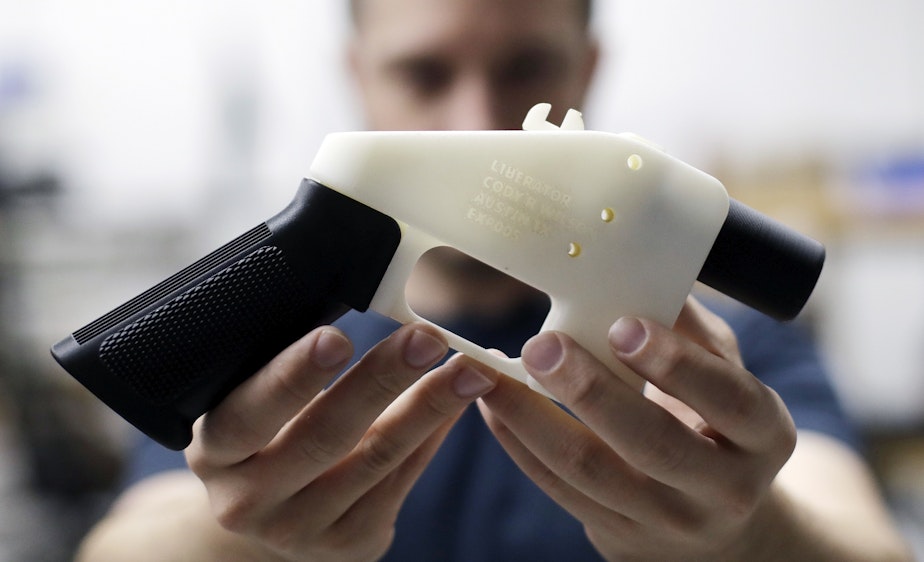Teens are using 3D printers to make guns in Seattle area

In February, a SeaTac mother called police after she found a firearm in her 13-year-old son’s bed.
She had no idea he had a gun — or how he’d get one.
This wasn’t a typical weapon. Police said the firearm, a loaded black handgun with five 9 mm rounds, was made using a combination of standard gun parts and pieces created using a 3D printer. A test fire with blanks found that the gun was functional, even with the flimsier plastic parts.
Washington state has passed some of the tightest gun regulations in the country. Still, teenagers in the Seattle area are getting their hands on, and even manufacturing, 3D-printed weapons from the comfort of their bedrooms, as illustrated by three recent King County Juvenile Court cases.
These printers can transform spools of plastic filament into any number of items, from figurines to pistol grips, one layer at a time.
“3D guns are an attractive option for anybody who can't legally obtain a firearm, and that includes young people as well,” said Nick Suplina, senior vice president for law and policy at Everytown for Gun Safety. “The biggest concern for us with 3D-printed guns is still extremists and crime syndicates.”
Sponsored
In the SeaTac case, a detective linked the 13-year-old teenager’s gun to a home in Burien, where police found a 3D printer, six in-progress 3D-printed handgun frames, and other gun parts purchased online.
A 14-year-old who lived in the Burien home had allegedly been communicating with the SeaTac teen, a friend who attended the same school, about ordering different firearm parts online and where to have them shipped.
Numerous online retailers sell individual gun parts or pre-made packages, typically advertised as “80-percent” kits, that include the bulk of the pieces needed to build an untraceable firearm. Washington state outlawed the selling of unfinished gun frames and receivers this year.
Police found that the two teens exchanged photos and video of guns being used. King County prosecutors initially charged both teenagers with unlawful possession of a weapon. Additionally, they charged the Burien teenager with manufacturing and intending to sell untraceable weapons, also known as ghost guns.
In a third case, Des Moines police arrested a 15-year-old teenager after an officer said he saw the teenager break the driver’s side window of a Kia, and attempt to steal it. When more police arrived, their sirens blaring, the teenager took off.
Sponsored
Police captured him and found a Glock 22, 9mm handgun and extended magazine next to him. The gun had a gold colored “Glock switch,” used to convert semi-automatic handguns into fully automatic weapons, that police suspected may have been 3D printed or made by a third-party company.
Before these cases made their way to King County courts, Washington state tried to limit gun access in federal court. In 2020, Washington’s Attorney General Bob Ferguson, leading a coalition of 21 attorneys general, sued the Trump Administration to prevent the release of 3D printed gun blueprints.
Gun parts created with a home 3D printer don’t have serial numbers, meaning they can’t be tracked if they’re seized by law enforcement. These firearms are a type of “ghost gun,” which police are seeing more of nationally, according to the Bureau of Alcohol, Tobacco, Firearms and Explosives. The bureau saw a more than 1,000% increase of ghost guns recovered by law enforcement and submitted to the bureau for tracing between 2017 and 2021.
In 2020, Seattle Police confiscated 16 privately made, unserialized full firearms, according to numbers provided by the department. In 2021, this number grew to 31. In 2022, that number more than doubled to 66 ghost guns.
Rafael Serrano, a data analyst for the King County Prosecuting Attorney’s Office, said there’s been an increase in the number of guns that are unlawfully possessed in the county — the bulk of which are stolen guns.
Sponsored
However, he said, “We are concerned about ghost guns and gun conversions.”
Recently, the Prosecuting Attorney’s office met with personnel from the Bureau of Alcohol, Tobacco, Firearms and Explosives to discuss an influx of ghost gun manufacturing in Canada where it’s more difficult to purchase firearms legally.
Guns created using a 3D printer remain in the minority in Seattle for now. Seattle Police aren’t encountering 3D printed weapons often, a spokesperson with the department said.
“The process of creating a 3D-printed gun is quite technical and complicated,” the Seattle Police spokesperson said. And the longevity of the plastic firearms is short, “due to the fragility of the material used.”
Suplina with Everytown For Gun Safety said law enforcement on the East Coast is seeing more 3D guns showing up on crime scenes. He said some departments are discussing the monitoring of “suspicious” 3D printer shipments.
Sponsored
“Ghost guns are an end run around our gun laws,” he said.




